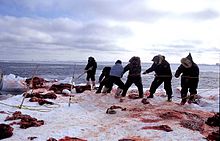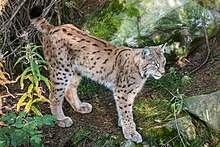The lion is one of Africa's apex land predators.
The saltwater crocodile is the largest living reptile and the dominant predator throughout its range.
The great white shark (bottom) was originally considered the apex predator of the ocean; however, the killer whale (top) has proved to be a predator of the shark
An apex predator, also known as an alpha predator or top predator, is a predator at the top of a food chain, without natural predators.
Apex predators are usually defined in terms of trophic dynamics, meaning that they occupy the highest trophic levels. Food chains are often far shorter on land, usually limited to being secondary consumers – for example, wolves prey mostly upon large herbivores (primary consumers), which eat plants (primary producers). The apex predator concept is applied in wildlife management, conservation and ecotourism.
Apex predators have a long evolutionary history, dating at least to the Cambrian period when animals such as Anomalocaris dominated the seas.
Humans have for many centuries interacted with apex predators including the wolf, birds of prey and cormorants
to hunt game animals, birds, and fish respectively. More recently,
humans have started interacting with apex predators in new ways. These
include interactions via ecotourism, such as with the tiger shark, and through rewilding efforts, such as the proposed reintroduction of the lynx.
Ecological roles
Effects on community
The great skua is an aerial apex predator, both preying on other seabirds and bullying them for their catches.
Apex predators affect prey species' population dynamics
and populations of other predators, both in aquatic and in terrestrial
ecosystems. Non-native predatory fish, for instance, have sometimes
devastated formerly dominant predators. A lake manipulation study found
that when the non-native smallmouth bass was removed, lake trout, the suppressed native apex predator, diversified its prey selection and increased its trophic level. As a terrestrial example, the badger, an apex predator, predates on and also competes with the hedgehog, a mesopredator,
for food such as insects, small mammals, reptiles, amphibians and
ground-nesting bird's eggs. Removal of badgers (in a trial investigating
bovine tuberculosis) caused hedgehog densities to more than double. Predators that exert a top-down control on organisms in their community are often considered keystone species.
Humans are not considered apex predators because their diets are
typically diverse, although human trophic levels increase with
consumption of meat.
Effects on ecosystem
Apex predators can have profound effects on ecosystems, as the
consequences of both controlling prey density and restricting smaller
predators, and may be capable of self-regulation. They are central to the functioning of ecosystems, the regulation of disease, and the maintenance of biodiversity. When introduced to subarctic islands, for example, Arctic foxes' predation of seabirds has been shown to turn grassland into tundra. Such wide-ranging effects on lower levels of an ecosystem are termed trophic cascades. The removal of top-level predators, often through human agency, can cause or disrupt trophic cascades. For example, reduction in the population of sperm whales, apex predators with a fractional trophic level
of 4.7, by hunting has caused an increase in the population of large
squid, trophic level over 4 (carnivores that eat other carnivores). This effect, called mesopredator release,
occurs in terrestrial and marine ecosystems; for instance, in North
America, the ranges of all apex carnivores have contracted whereas those
of 60% of mesopredators have grown in the past two centuries.
Conservation
The gray wolf is both an apex predator and a keystone species, affecting its prey's behaviour and the wider ecosystem.
Because apex predators have powerful effects on other predators, on
herbivores, and on plants, they can be important in nature conservation. Humans have hunted many apex predators close to extinction, but in some parts of the world these predators are now returning. They are increasingly threatened by climate change. For example, the polar bear requires extensive areas of sea ice
to hunt its prey, typically seals, but climate change is shrinking the
sea ice of the Arctic, forcing polar bears to fast on land for
increasingly long periods.
Dramatic changes in the Greater Yellowstone Ecosystem were recorded after the gray wolf, both an apex predator and a keystone species (one with a large effect on its ecosystem), was reintroduced to Yellowstone National Park in 1995 as a conservation measure. Elk, the wolves' primary prey, became less abundant and changed their behavior, freeing riparian zones from constant grazing and allowing willows, aspens and cottonwoods to flourish, creating habitats for beaver, moose and scores of other species. In addition to their effect on prey species, the wolves' presence also affected one of the park's vulnerable species, the grizzly bear: emerging from hibernation, having fasted for months, the bears chose to scavenge wolf kills, especially during the autumn as they prepared to hibernate once again.
The grizzly bear gives birth during hibernation, so the increased food
supply is expected to produce an increase in the numbers of cubs
observed. Dozens of other species, including eagles, ravens, magpies, coyotes and black bears have also been documented as scavenging from wolf kills within the park.
Human trophic level
Ecologists have debated whether humans
are apex predators. For instance, Sylvain Bonhommeau and colleagues
argued in 2013 that across the global food web, a fractional human
trophic level (HTL) can be calculated as the mean trophic level of every
species in the human diet, weighted by the proportion which that
species forms in the diet. This analysis gives an average HTL of 2.21,
varying between 2.04 (for Burundi, with a 96.7% plant-based diet) and 2.57 (for Iceland, with 50% meat and fish, 50% plants). These values are comparable to those of non-apex predators such as anchovy or pig.
However, Peter D. Roopnarine criticised Bonhommeau's approach in
2014, arguing that humans are apex predators, and that the HTL was based
on terrestrial farming where indeed humans have a low trophic level,
mainly eating producers (crop plants at level 1) or primary consumers
(herbivores at level 2), which as expected places humans at a level
slightly above 2. Roopnarine instead calculated the position of humans
in two marine ecosystems, a Caribbean coral reef and the Benguela
system near South Africa. In these systems, humans mainly eat predatory
fish and have a fractional trophic level of 4.65 and 4.5 respectively,
which in Roopnarine's view makes those humans apex predators.
Evolutionary history
Anomalocaris was an apex predator in the Cambrian seas.
Apex predators are thought to have existed since at least the Cambrian
period, around 500 million years ago. Extinct species cannot be
directly determined to be apex predators as their behaviour cannot be
observed, and clues to ecological relationships, such as bite marks on
bones or shells, do not form a complete picture. However, indirect
evidence such as the absence of any discernible predator in an
environment is suggestive. Anomalocaris
was an aquatic apex predator, in the Cambrian. Its mouthparts are
clearly predatory, and there were no larger animals in the seas at that
time.
Carnivorous theropod dinosaurs including Allosaurus and Tyrannosaurus have been described as apex predators, based on their size, morphology, and dietary needs.
A Permian shark, Triodus sessilis, was discovered containing two amphibians (Archegosaurus decheni and Cheliderpeton latirostre), one of which had consumed a fish, Acanthodes bronni, showing that the shark had lived at a trophic level of at least 4.
Among more recent fossils, the sabre-tooth cats, like Smilodon, are considered to have been apex predators in the Cenozoic.
Interactions with humans
Dogs have been used in hunting for many centuries, as in this 14th century French depiction of a boar hunt.
In hunting
Humans hunted with wolves and in turn with domestic dogs for some 40,000 years; this collaboration may have helped modern humans to outcompete the Neanderthals. Humans still hunt with dogs, which have often been bred as gun dogs to point to, flush out, or retrieve prey. The Portuguese Water Dog was used to drive fish into nets. Several breeds of dog have been used to chase large prey such as deer and wolves.
Eagles and falcons, which are apex predators, are used in falconry, hunting birds or mammals. Tethered cormorants, also top predators, have been used to catch fish.
In ecotourism
Tiger sharks are popular ecotourism subjects, but their ecosystems may be affected by the food provided to attract them.
Ecotourism sometimes relies on apex predators to attract business.
Tour operators may in consequence decide to intervene in ecosystems,
for example by providing food to attract predators to areas that can
conveniently be visited. This in turn can have effects on predator population and therefore on the wider ecosystem. As a result, provisioning of species such as the tiger shark is controversial, but its effects are not well established by empirical evidence. Other affected apex predators include big cats and crocodiles.
Rewilding
The reintroduction of predators like the lynx is attractive to conservationists, but alarming to farmers.
In some densely populated areas like the British Isles, all the large native predators like the wolf, bear, wolverine and lynx have become locally extinct, allowing herbivores such as deer to multiply unchecked except by hunting. In 2015, plans were made to reintroduce lynx to the counties of Norfolk, Cumbria, and Northumberland in England, and Aberdeenshire in Scotland as part of the rewilding movement. The reintroduction of large predators is controversial, in part because of concern among farmers for their livestock.
Conservationists such as Paul Lister propose instead to allow wolves
and bears to hunt their prey in a "managed environment" on large fenced
reserves.










